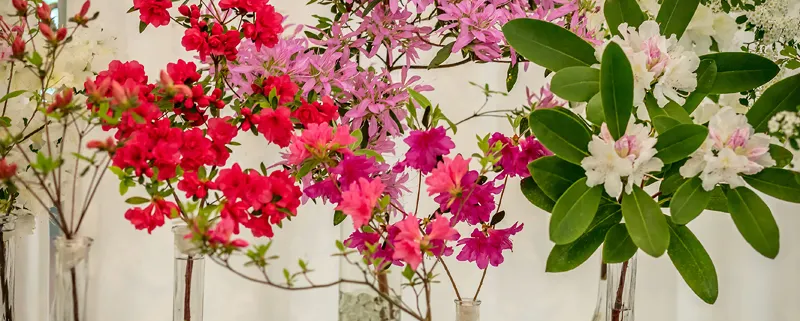Floral Shows Demystified
Why and How to Enter a Flower Show Class
1.Entering in horticulture classes expands your knowledge of growing your own beautiful plants to enjoy for years. Making your own floral design at home becomes so much easier and more enjoyable
- First time going to a show, go with fellow member. See the early moments of how a show is created the day of. You see the other plants being brought in for horticulture, you will want to try to grow something like that at home. You can grow plants in your home, you just have to find what plants like the environment you can provide for it. One “ordinary” plant grown well can be magnificent.
- You support a club flower show which that club greatly appreciates.
In turn, they will support our show.
In turn, educates the public who come to see the show
How To Enter A Horticulture Class
The Guidelines:
Grooming
No disease, insects, spray residue
Good shape– remove old blooms, dead or yellow leaves, imperfect foliage. Try to create symmetry. Remember brown magic marker tip to cover white wood cuts. Remove all unattractive foliage- people do not know how many leaves your plant originally had.
Pot
Clay, not plastic
Size, appropriate to plant
Clean (mineral oil tip)
Top dressing – Use peat moss, sheet moss (bulbs), very dark soil (Fafards), orchid bark, sand or pebble for cacti, succulents and alpines
Details
Nomenclature, Latin and common name
Download entry card, fill it out before you go to the show
Key card, if required, recheck details of requirements
Transporting exhibits to show location: wedge pots with cinder blocks, sand bags, newspaper, cardboard boxes, seat belts are good for large pots
MOST IMPORTANT ADVICE: READ THE SCHEDULE
SECOND MOST IMPORTANT ADVICE: FIND OUT HOW LONG YOU NEED TO OWN YOUR PLANT MATERIAL?
SPECIFIC CLASSES (Typical for most shows):
Par Class
- MUST HAVE OWNED THE PLANT FOR AT LEAST SIX MONTHS
- Judged against perfection of particular plant
- Must be above average
- Length of ownership is an important consideration (eight years versus seven months)
- Make sure your specimen does not fit in any other class (the reason why there is a par class)
Bulb Class
- Blooms all around and if possible, facing forward (with narcissus)
- Flowers should be of equal height, foliage of good color, clean, free of dirt and defect (you can use manicure scissors to cut out imperfections)
- Staking is usually required, but un-staked bulbs will be given extra consideration by the judges
- When planting your pot, jam as many bulbs in as possible
Cut Specimens
- Cut exhibit as late as possible, unless the particular plant material needs to be specially conditioned to last
- Never have foliage submerged in water when exhibiting
- Wedge bottle with cotton, moss, boxwood, or saran wrap so that the specimen stands straight in the container
- If you are not sure if flower is to be exhibited with foliage, cut with foliage
Standards in Topiary Class
- Stakes are allowed if necessary, but un-staked is preferred
- Make sure standard is in the exact center of the pot
BOOK SOURCES:
Hamel, Esther Veramae, The Encyclopedia of Judging and Exhibiting
Flower Show and Judging Guide, Download from The Garden Club of America website
SUGGESTED TOOLS TO BRING TO PASSING FOR EXHIBITING:
Plant mister, paint brushes, brown and black magic marker, scissors, manicure scissors, ruler or measuring tape
Entry Card Information
What does a Latin name mean?
A botanical name must have at least two words. Both genus and species are always italicized.
- It must always have the first, the genus: Ex. Forsythia viridissima
It may include any of the following:
- Species only: Forsythia viridissima
- Species and variety: Forsythia viridissima var. koreana
- Species and cultivar: Forsythia viridissima ‘Bronxensis’
- Cultivar only: Forsythia ‘Beatrix Farand’
The second name or specific epithet of the botanical name, in Latin, is generally accepted in lower case although Hortus Third capitalizes it if it is named for a person.
When the second name is not known, it is permissible to write sp. (species)
Subdivision of Species
Varieties are found in nature
Cultivar is a plant which has been selected and cultivated by man. May be either a hybrid or a variant arising in cultivation. It is always capitalized and in single quotes.



